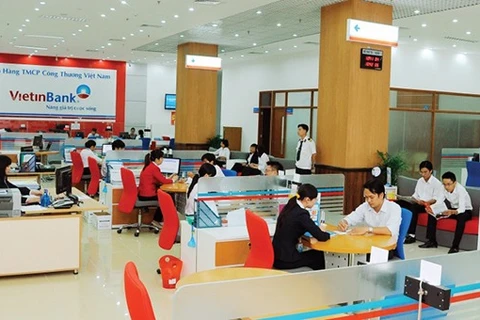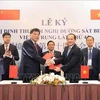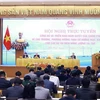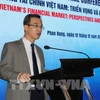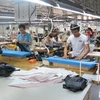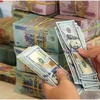Hanoi (VNS/VNA) - Last August, Prime Minister Nguyen Xuan Phuc issued Decision No.986/QD-TTg on the Development Strategy of the Banking Sector.
It caps the Government’s ownership of the three State-owned joint stock banks at 65 percent until 2021 and it would be reduced to 51 percent before 2025.
A foreign investor’s ownership of a bank cannot exceed 20 percent of its charter capital and the combined foreign shareholding is capped at 30 percent.
Analysts said however it is time for the Government to increase the foreign ownership ratio to 35 percent and then 40 and 49 percent to help the banks meet requirements amid the country’s rapid integration and be able to compete with international peers.
They listed reasons for the need to hike the cap.
Many foreign banks in Vietnam are now increasing their charter capital and expanding their branch networks significantly in a bid to increase their share in the lucrative market.
Meanwhile, joint stock banks, particularly those owned by the State, have difficulty increasing their capital, especially with Government resources stretched.
Increasing the foreign ownership ratio is thus one of the best solutions to help banks strengthen their financial capability.
Besides, globally, banks are making giant strides in adopting new technologies. So foreign investors’ greater involvement with local banks would help the latter quickly improve their technological capability.
Experts also said because of its bright prospects the Vietnamese economy is attracting enormous interest among foreign investors, and local banks would have no difficulty finding foreign strategic investors.
However, they said, the Government should amend some regulations, including on restrictions on foreign ownership of banks, to enable the lenders sell stakes to foreign investors.
The current 30 percent foreign ownership cap does not allow foreign investors to take part in the management of banks.
A senior economist, who asked not to be named, said the Ministry of Finance has allowed State-owned joint stock banks to retain their earnings instead of paying dividends to the Government to help them to increase their charter capital.
But he said this could only be a temporary solution while the banking sector needs a long-term one, which could only be the Government continuing to reduce its ownership so that lenders could increase foreign ownership.
Most of the State-owned joint stock banks expect the Government to increase the foreign ownership limit to attract foreign investors.
Vietnam now has four State-owned commercial banks, almost all of them in dire need of capital to meet the central bank’s Basel II requirements.
Le Duc Tho, Chairman of Vietinbank, said the bank has already reached its 30 percent foreign ownership limit and hopes the Government would soon increase the cap so that it could raise capital.
He also suggested gradually reducing the State-owned ownership ratio at banks to 51 percent instead of the current 65 percent after 2020.
A BIDV spokesperson said current regulations on banks’ stake sales to foreign investors are too stringent and banks find it difficult to strike deals to sell stakes.
Among the current regulations is the price at which banks sell their shares to foreign investors must not be lower than market prices, and investors must retain their shares for at least one year.
Partly due to such regulations, Vietcombank was able to sell only a 3-percent stake to Singapore sovereign fund GIC last year after originally planning to sell 7.73 percent. The bank can sell another 7 percent to foreign investors.
Many analysts believe that consumer credit would sustain its high growth momentum in 2019 to reach 1 quadrillion VND (42.92 billion USD) since demand remains high.
They attributed the high demand to a rise in household consumption and the large population of young people.
While incomes have yet to increase significantly, consumer demand for goods is rising relentlessly.
Dam The Thai, Deputy Director of HDBank’s HD Saison, concurred saying demand for vehicles, mobile phones, electrical and electronic appliances, and furniture would continue to rise strongly.
The influx of giant foreign investors into the retail market indicates the increasing consumer demand and the attractiveness of the consumer market.
Meanwhile, according to the Ministry of Planning and Investment, the country’s per capita income as of last October was 2,540 USD, still a far cry from next year’s target of 3,500 USD.
The slow increase in per capita income has resulted in a gap between demand and purchasing power.
Vietnam has a large population of above 90 million, of which over 70 percent are of working age, and average economic growth of over 6 percent, which has also contributed to increasing demand for consumer finance.
Besides, experts pointed out that though Vietnam’s consumer finance market has been growing rapidly in recent years it remains small compared to many other countries in the neighbourhood, meaning theoretically it has much room for further growth.
Data from the National Financial Supervisory Commission shows that consumer finance grew at a scorching 50.2 percent in 2016 and 65 percent in 2017, while the market share of consumer loans increased from 12.3 percent in 2016 to 18 percent in 2017 and continued to climb last year.
But most consumer financing is confined to urban areas, and rural and remote areas remain a market waiting to be exploited.
Besides, most consumer loans are related to housing, which makes the actual lending to buy consumer goods and services much lower. In this regard, the Vietnamese consumer finance market is still behind regional peers and abounds in growth opportunities.
But the enormous potential notwithstanding finance companies and banks face many difficulties developing the consumer financing segment, and need to have clear strategies if they want to capitalise.
One of their biggest challenges is risk management.
Most finance companies find it difficult to effectively carry out risk management because they do not have transparent information about their customers.
Besides, most retailers do not fully understand the importance of consumer lending in increasing their sales.
Consumers too do not know well about hire purchase and consumer finance, or have wrong views about the latter.
Another challenge is that the legal framework governing consumer finance sector is not robust enough to protect both finance companies and consumers.
Senior banking expert Can Van Luc said it is necessary to improve public enterprises’ awareness of consumer finance and consumer lending.
To do this, the Government needs to outline a national strategy on comprehensive finance development, financial education and strengthening the legal framework for consumer lending.-VNS/VNA
It caps the Government’s ownership of the three State-owned joint stock banks at 65 percent until 2021 and it would be reduced to 51 percent before 2025.
A foreign investor’s ownership of a bank cannot exceed 20 percent of its charter capital and the combined foreign shareholding is capped at 30 percent.
Analysts said however it is time for the Government to increase the foreign ownership ratio to 35 percent and then 40 and 49 percent to help the banks meet requirements amid the country’s rapid integration and be able to compete with international peers.
They listed reasons for the need to hike the cap.
Many foreign banks in Vietnam are now increasing their charter capital and expanding their branch networks significantly in a bid to increase their share in the lucrative market.
Meanwhile, joint stock banks, particularly those owned by the State, have difficulty increasing their capital, especially with Government resources stretched.
Increasing the foreign ownership ratio is thus one of the best solutions to help banks strengthen their financial capability.
Besides, globally, banks are making giant strides in adopting new technologies. So foreign investors’ greater involvement with local banks would help the latter quickly improve their technological capability.
Experts also said because of its bright prospects the Vietnamese economy is attracting enormous interest among foreign investors, and local banks would have no difficulty finding foreign strategic investors.
However, they said, the Government should amend some regulations, including on restrictions on foreign ownership of banks, to enable the lenders sell stakes to foreign investors.
The current 30 percent foreign ownership cap does not allow foreign investors to take part in the management of banks.
A senior economist, who asked not to be named, said the Ministry of Finance has allowed State-owned joint stock banks to retain their earnings instead of paying dividends to the Government to help them to increase their charter capital.
But he said this could only be a temporary solution while the banking sector needs a long-term one, which could only be the Government continuing to reduce its ownership so that lenders could increase foreign ownership.
Most of the State-owned joint stock banks expect the Government to increase the foreign ownership limit to attract foreign investors.
Vietnam now has four State-owned commercial banks, almost all of them in dire need of capital to meet the central bank’s Basel II requirements.
Le Duc Tho, Chairman of Vietinbank, said the bank has already reached its 30 percent foreign ownership limit and hopes the Government would soon increase the cap so that it could raise capital.
He also suggested gradually reducing the State-owned ownership ratio at banks to 51 percent instead of the current 65 percent after 2020.
A BIDV spokesperson said current regulations on banks’ stake sales to foreign investors are too stringent and banks find it difficult to strike deals to sell stakes.
Among the current regulations is the price at which banks sell their shares to foreign investors must not be lower than market prices, and investors must retain their shares for at least one year.
Partly due to such regulations, Vietcombank was able to sell only a 3-percent stake to Singapore sovereign fund GIC last year after originally planning to sell 7.73 percent. The bank can sell another 7 percent to foreign investors.
Many analysts believe that consumer credit would sustain its high growth momentum in 2019 to reach 1 quadrillion VND (42.92 billion USD) since demand remains high.
They attributed the high demand to a rise in household consumption and the large population of young people.
While incomes have yet to increase significantly, consumer demand for goods is rising relentlessly.
Dam The Thai, Deputy Director of HDBank’s HD Saison, concurred saying demand for vehicles, mobile phones, electrical and electronic appliances, and furniture would continue to rise strongly.
The influx of giant foreign investors into the retail market indicates the increasing consumer demand and the attractiveness of the consumer market.
Meanwhile, according to the Ministry of Planning and Investment, the country’s per capita income as of last October was 2,540 USD, still a far cry from next year’s target of 3,500 USD.
The slow increase in per capita income has resulted in a gap between demand and purchasing power.
Vietnam has a large population of above 90 million, of which over 70 percent are of working age, and average economic growth of over 6 percent, which has also contributed to increasing demand for consumer finance.
Besides, experts pointed out that though Vietnam’s consumer finance market has been growing rapidly in recent years it remains small compared to many other countries in the neighbourhood, meaning theoretically it has much room for further growth.
Data from the National Financial Supervisory Commission shows that consumer finance grew at a scorching 50.2 percent in 2016 and 65 percent in 2017, while the market share of consumer loans increased from 12.3 percent in 2016 to 18 percent in 2017 and continued to climb last year.
But most consumer financing is confined to urban areas, and rural and remote areas remain a market waiting to be exploited.
Besides, most consumer loans are related to housing, which makes the actual lending to buy consumer goods and services much lower. In this regard, the Vietnamese consumer finance market is still behind regional peers and abounds in growth opportunities.
But the enormous potential notwithstanding finance companies and banks face many difficulties developing the consumer financing segment, and need to have clear strategies if they want to capitalise.
One of their biggest challenges is risk management.
Most finance companies find it difficult to effectively carry out risk management because they do not have transparent information about their customers.
Besides, most retailers do not fully understand the importance of consumer lending in increasing their sales.
Consumers too do not know well about hire purchase and consumer finance, or have wrong views about the latter.
Another challenge is that the legal framework governing consumer finance sector is not robust enough to protect both finance companies and consumers.
Senior banking expert Can Van Luc said it is necessary to improve public enterprises’ awareness of consumer finance and consumer lending.
To do this, the Government needs to outline a national strategy on comprehensive finance development, financial education and strengthening the legal framework for consumer lending.-VNS/VNA
VNA




